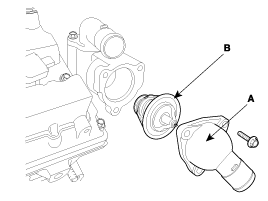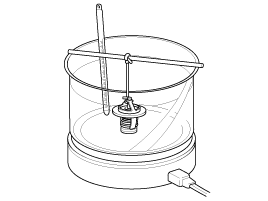 Hyundai Azera: Thermostat Repair procedures
Fifth generation HG (2011–2026) / Hyundai Azera 2011-2026 Service Manual / Engine Mechanical System / Cooling System / Thermostat Repair procedures
Hyundai Azera: Thermostat Repair procedures
Fifth generation HG (2011–2026) / Hyundai Azera 2011-2026 Service Manual / Engine Mechanical System / Cooling System / Thermostat Repair procedures
Fifth generation HG (2011–2026) / Hyundai Azera 2011-2026 Service Manual / Engine Mechanical System / Cooling System / Thermostat Repair procedures
| Removal |
Removal of the thermostat would have an adverse effect,
causing a lowering of cooling efficiency. Do not remove the thermostat,
even if the engine tends to overheat. |
| 1. |
Drain engine coolant so its level is below thermostat.
(Refer to Cooling System - "Coolant") |
| 2. |
Remove the ratiator upper hose.
(Refer to Cooling System - "Radiator Hose") |
| 3. |
Remove the water inlet fitting (A) and the thermostat (B).
|
| Inspection |
| 1. |
Immerse the thermostat in water and gradually heat the water.
|
| 2. |
Check the valve opening temperature.
If the valve opening temperature is not as specified, replace the thermostat. |
| 3. |
Check the valve lift.
If the valve lift is not as specified, replace the thermostat. |
| Installation |
| 1. |
Place the thermostat in thermostat housing.
|
| 2. |
Install the water inlet fitting (A).
|
| 3. |
Install the ratiator upper hose.
(Refer to Cooling System - "Radiator Hose") |
| 4. |
Fill with engine coolant. |
| 5. |
Start engine and check for leaks. |
 Thermostat Components and Components Location
Thermostat Components and Components Location
Components
1. Water temperature control assembly2. Thermostat3. Water inlet fitting
...
 Thermostat Troubleshooting
Thermostat Troubleshooting
Troubleshooting
SymptomsPossible CausesRemedyCoolant leakage
•
From the thermostat gasket
Check the mounting bolts
•
Check the torque of the mounting bolts
•
Retighten the bo ...
See also:
Basic Mode Screen
(1) Mode Displays currently operating mode.
(2) Operation State From Repeat / Shuffle, displays the currently operating function.
(3) Song Index Displays the current song/total number of songs.
( ...
Hood Assembly Components and Components Location
Component Location
1. Hood assembly
...
Front Door Outside Handle Repair procedures
Replacement
1.
Remove the hole plug (B).
2.
After loosening the mounting bolt, then remove the front door outside handle cover (A).
Tightening torque :
0.7 ~ 0.5 N.m (0.07 ~ 0.1 kgf.m, 1.0 ...
Categories
Hyundai Azera Manuals
© 2011-2026 Copyright www.hgmanual.com



